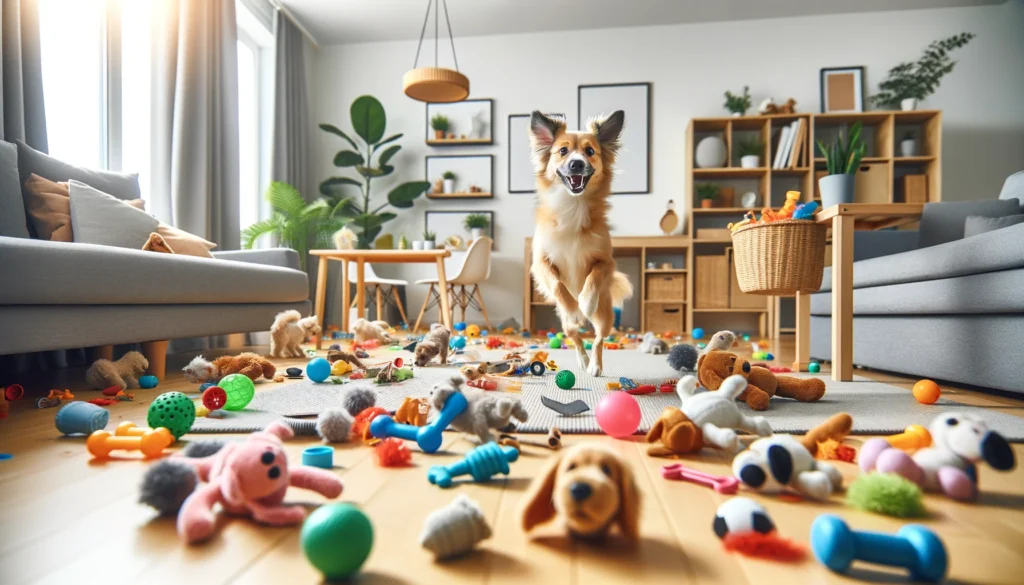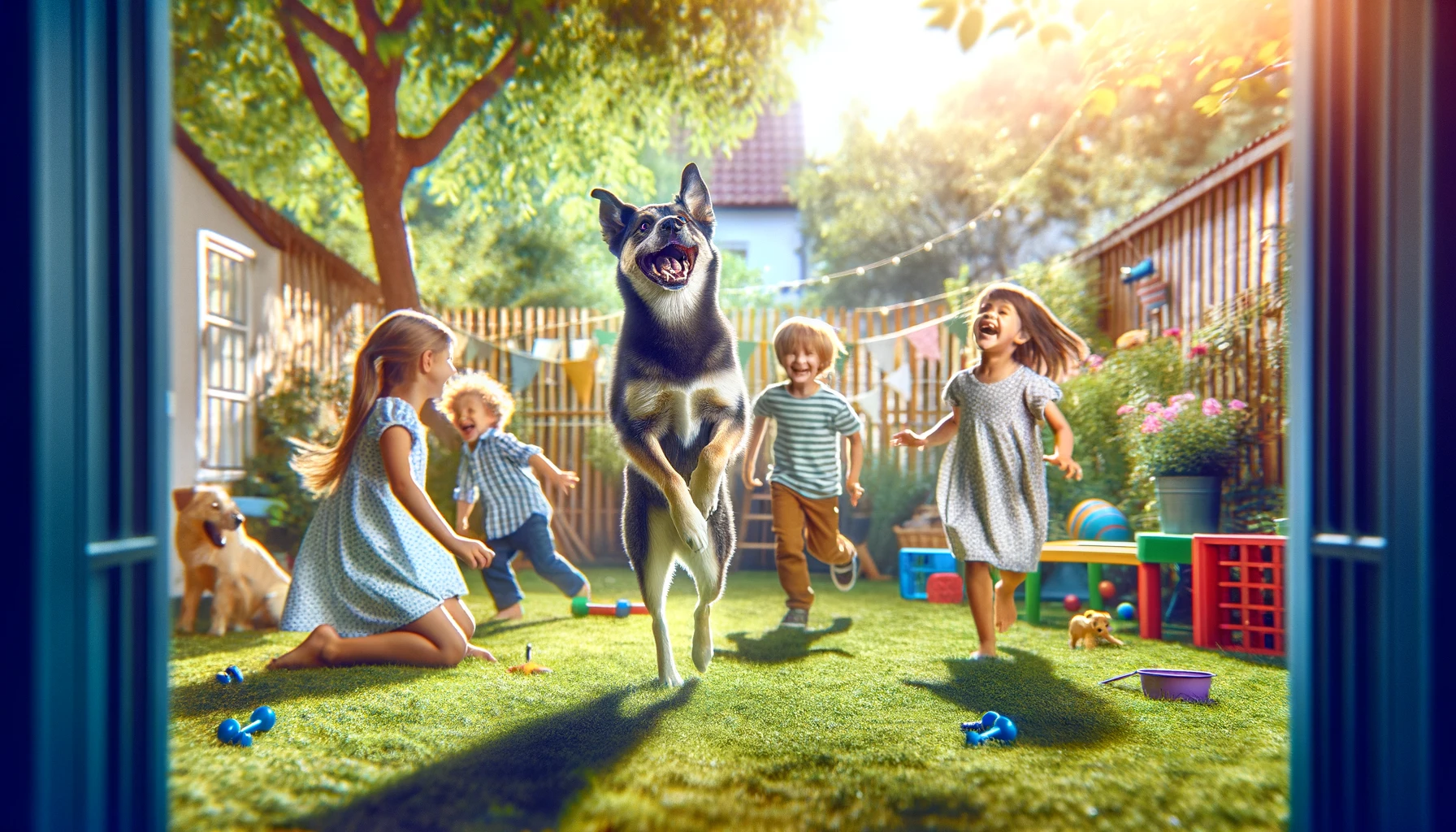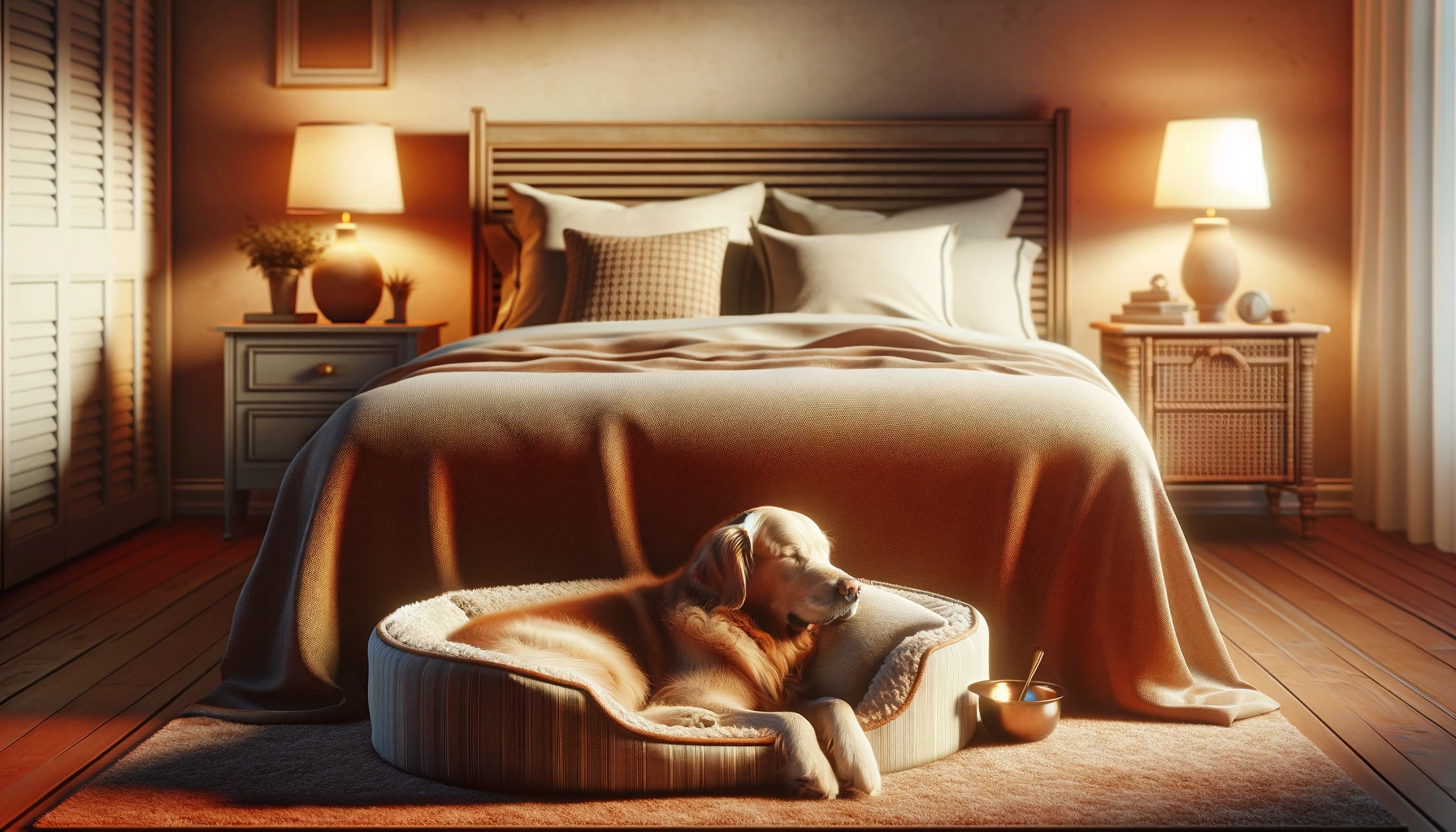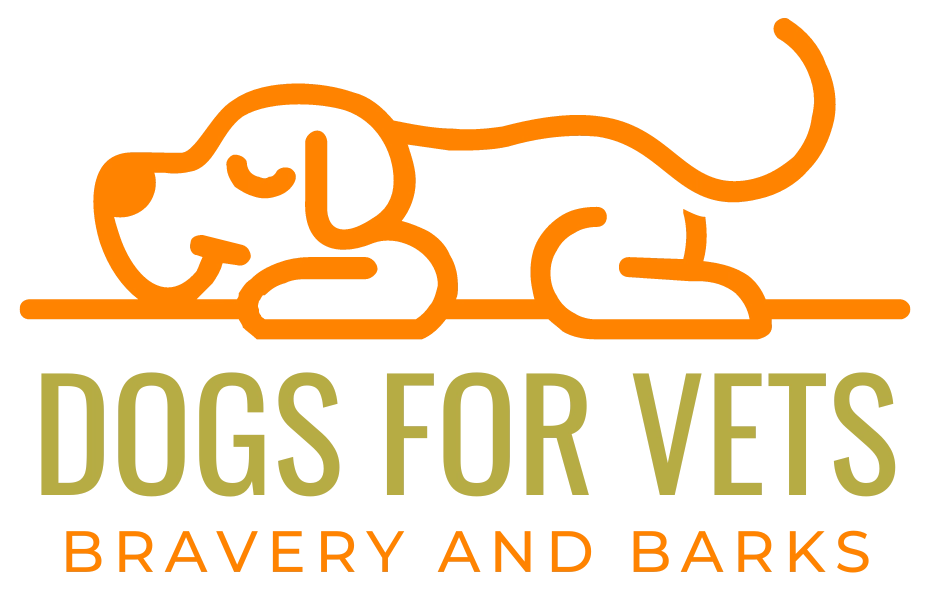This post may contain ads and affiliate links and we may earn a small commission when you click on the links at no additional cost to you. As an Amazon Affiliate, we earn from qualifying purchases. You can read our full disclaimer here.
How to Calm a Hyper Dog: Practical Solutions for a Better Pooch

If you’re wondering how to calm a hyper dog, you’re not alone.
Many dog owners find themselves at their wits’ end trying to manage their furry friend’s boundless energy.
Whether it’s endless bouncing off the walls or a case of the zoomies that never seems to end, a hyper dog can be a challenge.
From exercise hacks to calming techniques, we’re covering all the bases to help you and your dog find peace and relaxation.
How to Calm a Hyper Dog and What Exactly is Hyperactivity

What Does Hyperactivity Look Like in a Dog?
Hyper dogs have a lot of energy! They might run around a lot, have trouble sitting still, or act like they’re always excited.
They could also bark more than usual or jump up a lot. Imagine someone who’s had way too much coffee—that’s a hyper dog.
Why Do Dogs Get Hyper?
Several reasons can make a dog act this way. Let’s break it down:
- Lack of Exercise: Dogs need to move! Without enough exercise, their pent-up energy can show as hyperactivity.
- Boredom: Dogs get bored too. Without games, training, or puzzles, they can become restless.
- Stressful Environment: A noisy or busy home can stress dogs out, making them act hyper.
- Inconsistent Routine: Dogs thrive on routine. Without it, they might feel anxious and display hyper behaviors.
- Improper Diet: Some foods are too high in sugar or artificial ingredients for dogs, leading to energy spikes.
- Health Issues: Occasionally, underlying health problems can cause a dog to act out. Always consult a vet if you’re concerned.
Understanding why dogs get hyper can help us figure out the best ways to help them calm down.
It’s all about making sure they have what they need—exercise, fun things to do, a calm place, a good routine, and the right food.
Signs of Hyperactivity in Dogs

Identifying hyperactivity in dogs is key to understanding and managing their behavior effectively.
Hyperactive dogs display a range of signs that go beyond the typical energetic behavior seen in many dogs. These signs are often consistent and intense, affecting the dog’s ability to relax or focus.
Recognizing these signs early on can help in taking proactive steps to provide your dog with the right form of exercise, mental stimulation, and care they need to lead a balanced and happy life.
| Sign | Description |
|---|---|
| Excessive Barking | Barking at even the slightest stimuli, often without a clear reason. |
| Inability to Stay Still | Constantly moving, pacing, or fidgeting, even in normally calming situations. |
| Destructive Behavior | Chewing, digging, or destroying objects around the house out of restlessness. |
| Lack of Focus | Difficulty in paying attention during training or play, easily distracted by surroundings. |
| Jumping Up | Repeatedly jumping on people or furniture, struggling to control impulses. |
| Excessive Panting | Panting heavily without recent physical exertion, a sign of stress or overstimulation. |
| Zoomies | Sudden bursts of energy, running in circles or erratic patterns, often at full speed. |
Understanding these signs can help you better cater to your dog’s needs, ensuring they receive adequate physical activity and mental engagement to mitigate hyperactive tendencies.
How to Calm a Hyper Dog Practical Tips
Physical Exercise
Regular physical exercise is not just beneficial; it’s essential for managing a hyper dog’s boundless energy.
Exercise helps to burn off that excess energy in a healthy way, reducing hyperactive behaviors and promoting a calmer demeanor. A well-exercised dog is often a happy and less stressed dog.
Therefore, incorporating a variety of physical activities into your dog’s routine can make a significant difference in their overall behavior and well-being.
Here are ten specific activities to get your dog moving:
- Brisk Walking: A daily brisk walk, especially in new areas, provides both physical exercise and mental stimulation.
- Jogging or Running: Great for high-energy dogs, keeping pace with you as you jog or run.
- Fetch: Playing fetch with balls or frisbees is a classic way to tire out a dog.
- Tug-of-War: A controlled game of tug-of-war can provide good physical exercise and strengthen your bond.
- Agility Training: Setting up an agility course in your yard or joining a club can be both stimulating and tiring.
- Swimming: For dogs that love water, swimming is an excellent low-impact exercise.
- Hiking: Exploring trails offers new scents and sights, adding mental stimulation to physical exertion.
- Cycling: Biking with your dog running alongside can be a great way for both of you to get exercise.
- Flirt Pole: A flirt pole is a stick with a rope attached to it, ending in a toy. It mimics the movements of prey and provides a vigorous workout.
- Stair Climbing: Encouraging your dog to run up and down stairs (if safe) is a quick way to wear them out.
Incorporating a mix of these activities into your dog’s routine can significantly help manage hyperactivity by ensuring they’re getting the physical outlet they need.
Mental Stimulation
Just as physical exercise is crucial for a dog’s well-being, mental stimulation plays a key role in tiring out a hyper dog.
Mental exercises challenge a dog’s brain, helping to drain energy in a different but equally effective way as physical activity.
Engaging a dog’s mind can also prevent boredom, reduce stress, and improve their problem-solving skills.
By adding mental stimulation into your dog’s daily routine, you can help them become more balanced and calm.
Here are ten activities that provide excellent mental exercise:
- Puzzle Toys: Toys that require dogs to solve puzzles to get treats are great for mental engagement.
- Training Sessions: Regular, short training sessions using positive reinforcement keep dogs focused and learning.
- Hide-and-Seek: Hiding from your dog or hiding treats for them to find engages their senses and problem-solving skills.
- New Tricks: Teaching your dog new tricks or commands provides mental stimulation and strengthens your bond.
- Interactive Games: Games like “which hand” or teaching them to sort toys by color or size can be mentally challenging.
- Snuffle Mats: These mats hide treats among fabric strips, encouraging dogs to use their sense of smell to find their rewards.
- DIY Obstacle Course: Setting up a homemade obstacle course indoors can challenge their ability to follow commands and navigate.
- Food-Dispensing Toys: Toys that dispense food as they are manipulated require dogs to think and move, providing dual stimulation.
- Scent Work: Teaching your dog to identify and follow scents can be an engaging activity that tires them mentally.
- Socialization Outings: Visits to new environments or meeting new people and pets can provide mental stimulation through new experiences.
By offering a variety of these mental exercises, you can help ensure your dog is receiving a well-rounded routine that addresses both their physical and mental needs, leading to a more content and calm demeanor.
How to Calm a Hyper Dog by Establishing a Routine

A consistent daily schedule for feeding, exercise, and sleep plays a pivotal role in managing a hyper dog’s energy levels.
Establishing a routine provides your dog with a sense of predictability and security, which is essential for their mental well-being.
Dogs thrive on knowing what to expect; it helps them feel more settled and less anxious, directly impacting their overall behavior and hyperactivity levels.
Benefits of a Routine
- Reduced Anxiety: Knowing what comes next reduces stress and anxiety in dogs, as unpredictability can lead to nervous energy.
- Improved Behavior: A routine helps dogs understand the boundaries and expectations, leading to improved behavior and easier training.
- Better Sleep Patterns: Regular sleep times help regulate a dog’s internal clock, leading to more restful sleep and less restlessness.
- Healthier Eating Habits: Scheduled feeding times regulate a dog’s digestive system and can prevent overeating and obesity.
- Increased Trust: Consistency in daily activities strengthens the bond between you and your dog, increasing their trust and security.
Implementing a Routine
Creating a routine involves setting specific times for activities like walks, playtime, meals, and bedtime, and sticking to them as closely as possible each day.
For example, morning walks should be at the same time every day, followed by breakfast, then play or training time. Evenings can include another walk, dinner, and some quiet time before bed.
This predictability helps a dog understand what is expected of them and when, reducing the likelihood of hyperactive outbreaks due to boredom or excess energy.
It also makes it easier for owners to plan their day, knowing when their dog will be most active and when they will need quiet time.
Establishing a routine is not just about creating a schedule; it’s about providing your dog with a framework that supports their physical and emotional well-being.
This structure can significantly reduce hyperactivity by meeting their basic needs for exercise, nutrition, and rest, while also providing stability and security.
Calming Techniques
When dealing with a hyper dog, sometimes what they need most is to learn how to settle down and relax.
Techniques like massage, calming music, and designated quiet time can make a world of difference in helping your dog find their inner peace.
Applying these methods consistently can teach your dog to associate certain times of the day or certain actions with relaxation and calm.
| Technique | Description | How to Apply |
|---|---|---|
| Massage | Gentle physical touch can relax and soothe your dog. | Use slow, gentle strokes along your dog’s body, paying special attention to behind the ears, under the chin, and along the back. |
| Calming Music | Music specifically designed to be calming for dogs can reduce anxiety and hyperactivity. | Play soft, soothing music during times of rest or before bedtime to signal it’s time to calm down. |
| Quiet Time | Designating a specific time and place for relaxation can help your dog wind down. | Create a comfortable, quiet space free from distractions where your dog can relax at the same time each day. |
| Aromatherapy | Certain scents are known to have a calming effect on dogs. | Use dog-safe essential oils like lavender in a diffuser in the room where your dog relaxes. |
| Deep Pressure Therapy | Similar to swaddling a baby, applying gentle pressure can provide a sense of security. | Use a weighted blanket or vest designed for dogs to provide comforting pressure. |
| Slow Feeding | Eating too quickly can be stressful for dogs; slow feeding encourages calmness. | Use slow feeder bowls or scatter feeding to prolong meal times and promote calm eating. |
| Controlled Breathing | Dogs pick up on our energy; controlled breathing can help both you and your dog relax. | Practice slow, deep breaths in your dog’s presence to encourage them to mirror your calm state. |
| Structured Play | Controlled play sessions can help release pent-up energy in a calm manner. | Engage in low-key play activities that don’t overexcite your dog, like gentle tug-of-war or slow fetch. |
| Routine Cuddling | Regular, calm cuddle time can help reassure and relax your dog. | Set aside time daily for quiet, peaceful cuddling, using it as a way to bond and calm your dog. |
| Visual Stimulation | Gentle visual stimuli can help distract and calm a dog. | Play videos designed for dogs that feature calming scenes and slow movement. |
Professional Help
Despite your best efforts with exercise, mental stimulation, routine establishment, and calming techniques, some dogs may continue to exhibit signs of hyperactivity that go beyond the scope of normal energetic behavior.
In these cases, consulting with a professional becomes not just an option, but a necessary step toward ensuring your dog’s health and happiness.
When to Seek Professional Help
- Persistent Hyperactivity: If your dog remains hyperactive despite implementing the strategies outlined, it might indicate an underlying issue.
- Behavioral Changes: Sudden or extreme changes in behavior warrant professional evaluation.
- Stress or Anxiety Symptoms: If your dog shows signs of severe stress or anxiety, professional intervention can provide targeted strategies for relief.
- Health Concerns: Hyperactivity can sometimes stem from medical conditions that require veterinary attention.
Seeking help from a veterinarian or a certified dog behaviorist is a responsible action.
A vet can rule out or treat any medical conditions that might be contributing to the hyperactivity.
A dog behaviorist, on the other hand, can offer specialized training strategies tailored to your dog’s needs, helping to manage their energy levels more effectively.
The Role of Professionals
- Veterinarians: Can assess and treat medical conditions, offer nutritional advice, and provide general guidance on managing hyperactivity.
- Dog Behaviorists: Specialize in understanding dog behavior, offering customized training programs and techniques to mitigate hyperactive behavior.
Remember, seeking professional help does not mean you have failed as a pet owner. Rather, it shows a commitment to your dog’s well-being and a willingness to do what’s best for them.
By taking this step, you’re ensuring your dog receives the comprehensive care they need to lead a balanced and happy life.
Things to Avoid
In the quest to calm a hyper dog, it’s crucial to steer clear of certain approaches that can do more harm than good.
While it can be frustrating to deal with a hyperactive dog, certain reactions might exacerbate the issue rather than alleviate it. Understanding what to avoid is as important as knowing what to do.
Common Mistakes to Avoid
- Yelling or Loud Scolding: Raising your voice can increase your dog’s anxiety and excitement levels, leading to more hyperactive behavior.
- Physical Punishment: This can harm your relationship with your dog, increase their stress levels, and potentially lead to aggressive behavior.
- Inconsistency: Failing to be consistent with commands, rules, and routines can confuse your dog and contribute to hyperactivity.
- Overstimulation: Providing too much stimulation, such as too many high-energy games without downtime, can overexcite your dog.
- Neglecting Exercise Needs: Skipping daily walks or play sessions can leave your dog with excess energy, leading to hyperactivity.
- Ignoring the Problem: Assuming your dog will outgrow hyperactivity without intervention might result in entrenched behaviors that are harder to change later on.
Why These Approaches Fail
The approaches listed above fail because they do not address the root causes of hyperactivity. Instead, they may instill fear, confusion, or anxiety in your dog, worsening the problem.
Effective management of hyperactivity involves patience, understanding, and positive reinforcement techniques that build trust and confidence between you and your dog.
The Path Forward
Focusing on positive reinforcement, consistent training, adequate exercise, and mental stimulation can make a significant difference in your dog’s behavior.
It’s about creating a supportive environment that encourages calmness and focus. If you’re unsure about how to proceed, or if the situation doesn’t improve, seeking advice from professionals is a constructive step forward.
Remember, every dog is unique, and finding the right balance of activities, training, and relaxation techniques can take time. Patience and persistence are key.
Final Thoughts on How to Calm a Hyper Dog
Calming a hyper dog requires a blend of understanding, patience, and consistent effort.
By recognizing the signs of hyperactivity, incorporating both physical and mental exercises, establishing a routine, applying calming techniques, and knowing when to seek professional help, you can make a significant difference in your dog’s behavior.
It’s important to avoid common pitfalls that can exacerbate hyperactivity, such as yelling or inconsistency, and instead focus on positive reinforcement and creating a supportive environment for your dog.
Remember, every dog has its unique personality and needs; what works for one might not work for another.
Stay patient, be willing to adapt, and always approach your dog’s hyperactivity with empathy and care.
With time and dedication, you can help your hyper dog become more relaxed and well-behaved, leading to a happier life for both of you.
-

Coffee Mug – In Dog Coffees I’ve Only Had One
$11.95 – $14.95 Select options This product has multiple variants. The options may be chosen on the product page
